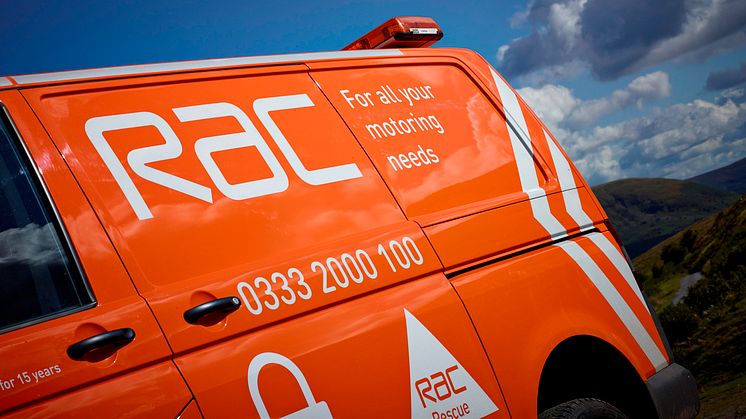
Press release -
RAC urges motorists not to get caught out this winter
Patrols saw 132% increase in ditched vehicles last winter
After one of the toughest winters on the road for years which saw the RAC attending over 100,000 breakdowns in just 11 days, the motoring organisation is urging drivers to learn the lessons of last winter and do all they can to make sure that they don’t get caught out by severe weather this year.
When the snow struck between 14th and 24th January RAC patrols went into overdrive, going to the aid of stricken motorists all across the country. In fact, Monday 21st January 2013 proved to be the RAC’s busiest day since 2007 with its patrols going to the rescue of more than 12,000 motorists.
March was little different, turning out to be the busiest March since 2008, with a total of 214,865 breakdowns dealt with. In all RAC patrols attended 100,000 more breakdowns than the previous winter.
Between December and March the RAC saw increases in a wide range of winter-related issues at the roadside. Most dramatically there was a 132% increase in vehicles being ‘ditched’ or stuck with nearly 5,200 suffering that fate compared to 2,220 in the same period in 2011/2012.
Problems with windscreen washers saw a 67% rise – the second largest percentage increase and no doubt caused by a lack of protective screen wash – while issues with diesel fuel filters becoming clogged due to lack of maintenance, exacerbated by the extreme cold, accounted for a 62% rise.
Damaged or distorted wheels went up by 34% – a likely result of more potholes and collisions with the kerb when skidding – and the fifth biggest increase was down to brake-related problems, often caused by handbrakes or rear brake mechanisms getting frozen.
Accidents were 27% up with patrols attending over 21,000 in the four months worst affected by the weather. Other common winter issues which led to greater breakdown volumes compared to the same period last year were frozen engines, caused by a lack of anti-freeze in coolant (24% up), faulty alternators (14% up) and clutch assemblies (9% up).
In terms of sheer volume of problems, batteries topped the list, being responsible for nearly 173,000 breakdowns, the majority (60%) of which were for depleted batteries that could not be brought back to life.
RAC technical director David Bizley said: “With forecasters predicting more severe weather this winter we want everyone to be well prepared as we know that the problems it causes motorists. Some are related to the decision to travel and some are unfortunately down to lack of preparation, whether that’s not maintaining vehicles properly or not making sure cars and their drivers are well-equipped for the conditions.
“The message we want to get across this winter is that carrying out a few simple checks before the cold weather really sets in could prevent you having to spend hours in the freezing cold or worse.
“Some breakdowns are avoidable through maintenance and preparation, and some roadside incidents brought on by the driving conditions such as vehicles getting stuck or involved in accidents could be prevented by taking extra caution, leaving more distance behind the car in front or getting a set of winter tyres which provide greater traction on winter roads.”
While we can’t predict the weather, there are various steps which drivers can take to make themselves less prone to breakdowns during the winter months. From checking your oil to packing a torch, here are the RAC’s top tips to ensure you don’t grind to a halt in the cold this year.
Preparing your car:
- Car Battery – cold weather, coupled with increased use of lights, wipers and heating, can wear down your car’s battery during the winter. If your battery is over four years old it could begin to become temperamental so get it checked and/or replaced before the coldest weather sets in. You can also buy products which can both check and charge your car’s battery to reduce the risk of problems. The RAC Shop offers a range of battery testers and chargers which let you check and maintain the condition of your battery
- Coolant – ensure that coolant is between the minimum and maximum markers. It is also important that there is sufficient anti-free in the coolant. If you're uncertain, have a look at your handbook or get a local garage to check the strength. Anti-freeze is cheap but damage from a frozen engine can be very expensive to put right
- Screenwash – windscreen washer fluid and anti-freeze are more crucial during the winter, so ensure that this is well topped-up before the cold weather arrives. Use a good quality windscreen wash that protects down to at least -10C – or -20C if you live in an area that experiences extremes of weather – to prevent the water from freezing. If you don’t your windscreen wipers could be rendered useless in extreme conditions
- Oil – As at any time of year, checking your oil level regularly is an easy way to reduce your risk of engine problems. This is the single most important vehicle maintenance check that you can do. Check your handbook so you have the correct oil for your vehicle and ensure it is fully changed at the right service intervals
- Lights – some cars will be driven for much of the summer without using the lights at all, so any problems may go undetected until they are needed. Therefore, a thorough check of all the lights on your car (including indicators, fog lights and full beams) is advised before winter sets in
- Wiper blades – check that your windscreen wiper blades are up to the task of dealing with heavy rain or snow before setting off on your journey. Replacing them is cheap and simple and could prove vital in getting you to your destination during poor conditions. One tip to keep your wiper blades in good condition is to never turn your wipers on before removing ice from the windscreen, as this can damage the blades.
- Tyres – fitting winter tyres to your car will make it much better-equipped to cope with hazardous driving conditions. However, even if you stick with your regular tyres, you must make sure they’re up to scratch. As well as looking for any obvious signs of wear or damage, check the pressure of each tyre regularly and also ensure there is adequate tread depth. And don’t forget to check the spare as well – if your car has one. It might also be worth investing in a set of snow socks
Packing your car:
We all know that even the best-laid plans can sometimes go awry, and sometimes even the most diligent drivers can be caught out by an unexpected breakdown. So it’s best to be prepared for every eventuality by ensuring that your car is equipped with all of the following in case you run into any trouble during the winter months:
- De-misting pad
- Torch (ideally wind-up so you never run out of battery)
- Spare screenwash
- De-icer
- Ice scraper
- Blanket
- Shovel
- In-car phone charger
- Road atlas
- Traction aid to give your tyres extra grip if slipping on snow or ice – or alternatively a strip of carpet, ideally one foot by three feet
Visit the RAC Shop for your winter driving essentials: www.racshop.co.uk/winter-driving.html
Advice: driving in icy conditions
- Only drive if it’s absolutely necessary and don't be afraid to turn back if you think the conditions are too treacherous
- If you’re driving to meet someone, let them know where you are travelling and when you expect to arrive, and leave extra time for your journey
- You may need to leave as much as 10 times the normal recommended gap between you and the car in front
- If you do encounter a skid, steer into it – for example, if the rear of the car is sliding to the right, steer to the right in order to regain control. Do not take your hands off the steering wheel or stamp your foot on the brakes
- Controls such as the brakes, as well as the steering, accelerator and even gear changing should be operated both smoothly and slowly
- A higher gear – two or three – may be more appropriate to aid the tyres gripping when moving off on packed ice
Topics
Notes to Editors
About the RAC
First formed in 1897, the RAC has been looking after the needs of its members and championing the interests of drivers for more than 120 years.
Today it has more than eight million members and is one of the UK’s most progressive motoring organisations, providing services for both private and business motorists. Whether it's roadside assistance, insurance, buying a used car, vehicle inspections and checks, legal services or up-to-the-minute traffic and travel information – the RAC offers a solution for all motoring needs. The RAC is committed to making motoring easier, safer, more affordable and more enjoyable for drivers and road users.
The RAC is the motorist’s champion and campaigns to support the interests of its members and UK drivers at a national level. This includes voicing concerns about the increasing cost of motoring, particularly the price of fuel and the high level of tax levied on it, advancing levels of road safety, and supporting the needs of all drivers, from young to old.
The RAC’s annual Report on Motoring – first published in 1989 – is one of a kind and provides a clear insight into the concerns and issues facing today’s motorists.
For the very latest news on UK fuel prices, check RAC Fuel Watch. It provides a comprehensive guide to the latest UK unleaded petrol and diesel prices – both at the wholesale level and at the pump - and tracks these prices daily to help drivers check if the price they pay to fill up is a fair one.

